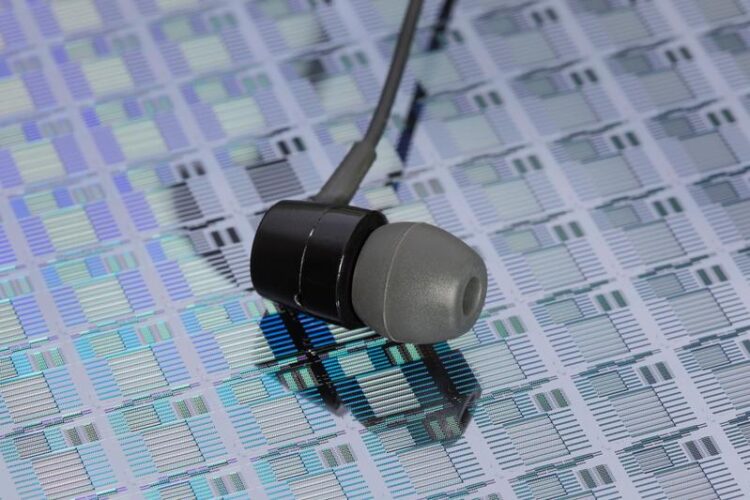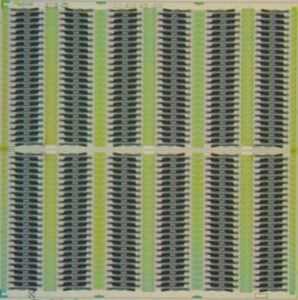The sound of joy in your ear

The innovative loudspeaker concept is based on the NED technology of Fraunhofer IPMS.
©Fraunhofer IPMS
We want modern technology to become smaller and more energy-efficient without losing quality. Technical innovation is needed to achieve this. For several years, the Fraunhofer Institute for Photonic Microsystems IPMS has been researching a novel energy-efficient actuator system for micro loudspeakers. The prototype now presented has surpassed expectations: High volume and excellent sound quality meet high energy efficiency in practical tests. The results were now presented in the Nature Journal Microsystems & Nanoengineering.

© Fraunhofer IPMS
The research team led by Dr Bert Kaiser, Manager Business Unit Monolithically Integrated Actuator and Sensor Systems at Fraunhofer IPMS, has been conducting research for years on a unique actuator system for wireless micro loudspeakers. With an arrangement of three electrodes in a common movable configuration on a beam, the Fraunhofer Institute presented for the first time a symmetrical bending transducer that embodies the push-pull principle and operates at low voltages. A first modeling approach was already presented in the journal Microsystems and Nanoengineering last year. The new paper now shows test results of the first prototype, which have confirmed the predictions from the theoretical approaches.
Bert Kaiser reports: “By implementing our novel push-pull actuators in a MEMS micro loudspeaker, we have in particular demonstrated the feasibility of a commercially highly attractive application.” The first balanced micro loudspeaker shows excellent audio reproduction over a wide frequency range of more than nine octaves (10 Hz to 6:3 kHz) with a distortion factor of less than 1.2 %. “We therefore expect that this electrode configuration will stimulate the development of innovative electrostatic actuators for a wide range of applications. In this context, it is also important to mention that the silicon fabrication technology is compatible with the complementary metal-oxide semiconductor technology,” Bert Kaiser added.
The Fraunhofer IPMS micro-speakers also promise great reductions in power consumption and peak current draw. “With the tiny batteries of modern in-ear devices (typically 60 mAh), most of the battery budget is reserved for smart features such as speech recognition and wireless connectivity,” Kaiser explains. This limits the power available to the audio playback system to a small, single-digit milliwatt number. “Micro loudspeakers have to beat this target to be competitive with classic electrodynamic or balanced-armature loudspeakers,” says the business unit manager.
The combination of a comparatively low signal voltage and low actuator capacitance present in Fraunhofer IPMS’ micro-speakers allows the micro-speaker to be driven by small, highly efficient actuators connected to a small lithium-polymer or zinc-air battery. The speaker chips have a total electrical capacitance of much less than 1 nF. In comparison, capacitance values of over 20 nF or even 150 nF have been published for piezoelectric systems.
“Our further research on the system will also focus on technology development to reduce the minimum possible gap distances while increasing space utilization,” concludes Bert Kaiser.
Spin-off Arioso Systems GmbH
In 2019, the commercialization of the research results on the micro loudspeakers was taken over by Arioso Systems GmbH, which was spun off from Fraunhofer IPMS. Arioso Systems GmbH became part of Bosch Sensortec GmbH in 2022.
Researchers at Fraunhofer IPMS will continue to work on the implementation of further ideas in a joint partnership with Bosch Sensortec GmbH. These aim to turn the initial idea of a new loudspeaker concept into a sustainable innovation impulse.
About Fraunhofer IPMS
The Fraunhofer Institute for Photonic Microsystems IPMS is a provider of applied research and development in the fields of industrial manufacturing, medical technology and mobility. Our research focuses on miniaturized sensors and actuators, integrated circuits, wireless and wired data communication, and customized MEMS systems.
Originalpublikation:
Media Contact
All latest news from the category: Power and Electrical Engineering
This topic covers issues related to energy generation, conversion, transportation and consumption and how the industry is addressing the challenge of energy efficiency in general.
innovations-report provides in-depth and informative reports and articles on subjects ranging from wind energy, fuel cell technology, solar energy, geothermal energy, petroleum, gas, nuclear engineering, alternative energy and energy efficiency to fusion, hydrogen and superconductor technologies.
Newest articles

Sea slugs inspire highly stretchable biomedical sensor
USC Viterbi School of Engineering researcher Hangbo Zhao presents findings on highly stretchable and customizable microneedles for application in fields including neuroscience, tissue engineering, and wearable bioelectronics. The revolution in…

Twisting and binding matter waves with photons in a cavity
Precisely measuring the energy states of individual atoms has been a historical challenge for physicists due to atomic recoil. When an atom interacts with a photon, the atom “recoils” in…

Nanotubes, nanoparticles, and antibodies detect tiny amounts of fentanyl
New sensor is six orders of magnitude more sensitive than the next best thing. A research team at Pitt led by Alexander Star, a chemistry professor in the Kenneth P. Dietrich…





















